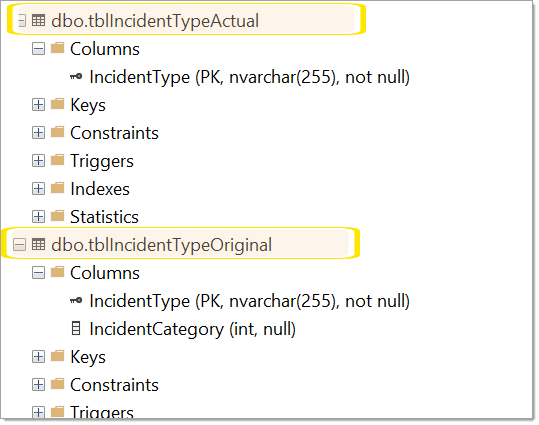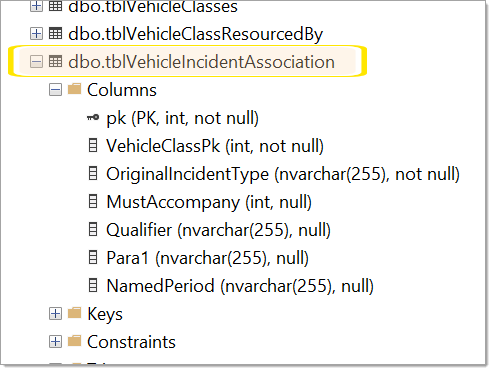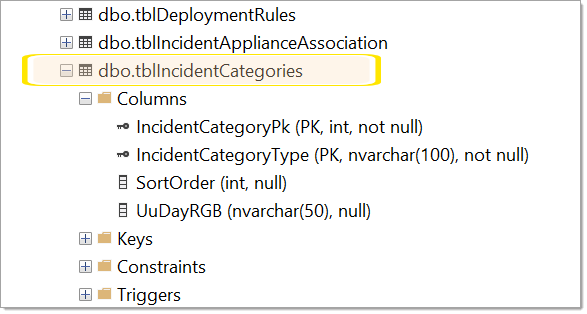Incident Types- editing in SQL Server
To edit Incident Types, open Microsoft SQL Server Management Studio and connect to your database.
Navigate to these tables and double-click on any entry to edit.
Actual Incident Types
Opens the table of Actual Incident Types tblIncidentTypeActual for editing.
Field IncidentType contains an incident code. This is the basis of the filter for Actual Incident types.
Original Incident Types
Opens the table of Original Incident Types tblIncidentTypeOriginal for editing.
- Field IncidentType contains an incident code. Note, in addition to the ‘real’ incident codes there must also be a code “*”.
- Field IncidentCategory enter a category from the drop-down box, i.e. Primary or Secondary.
Incident - Vehicle Mapping
Opens the table which defines what types of incidents a class of vehicle can attend tblVehicleIncidentAssociation.
Note: This is only for non-special-request vehicles.
If a vehicle can attend all incident types, it must be assigned the incident type “*”. If it can attend only certain types, they can be specified here in each field.
Incident Categories
Opens the table defining the Incident Categories tblIncidentCategories.
Remember to define a unique ‘key’, e.g. 1, 2, etc. and a user-friendly name such as ‘Primary’.
Incident Response Times
Opens the table defining Target Response Times for incidents of a specific category.
Example:
This opens the table defining Target Response Times for incidents of a specific category.
| Row | IncidentCategoryPk | VehicleArrivingPosition | ResponseTime |
| 1 | Primary | 1 | 5 minutes |
| 2 | Primary | 3 | 10 minutes |
| 3 | Secondary | 1 | 20 minutes |
For each Category it is necessary to define Response Times against Vehicle Arriving Position.
VehicleArrivingPosition refers to all vehicles up to this position from a lower defined position, i.e. VehicleArrivalPosition=1 sets the time for the 1st vehicle, VehicleArrivalPosition=3 sets the time for the 2nd and 3rd vehicles as it ‘sits’ above VehicleArrivalPosition=1.
Row 1: This defines the target time for the 1st appliance to be 5 minutes for a Primary incident.
Row 2: This defines the target time of 10 minutes for appliances up to and including the 3rd appliance for a Primary incident.
Row 3: This defines the target time for the 1st appliance to be 20 minutes for a Secondary incident.
The above table specifies:
- For a Primary incident the response time for the 1st appliance is 5 minutes; the response time for the 2nd and 3rd appliance is 10 minutes; for subsequent appliances there is no limit/target.
- For a Secondary incident the response time for the first appliance is 20 minutes; for subsequent appliances there is no limit/target.
If Row 1 is deleted then the 1st, 2nd and 3rd vehicles will have a ResponseTime of 10 minutes for Primary Incidents.
Property Type
A text column is added to the incidents table:
- tblIncidents.PropertyType
This can be populated by Data/Import by specifying in settings.txt the column in the incident data that contains relevant property information, e.g.
- DataFieldIncidentPropertyType = 12

